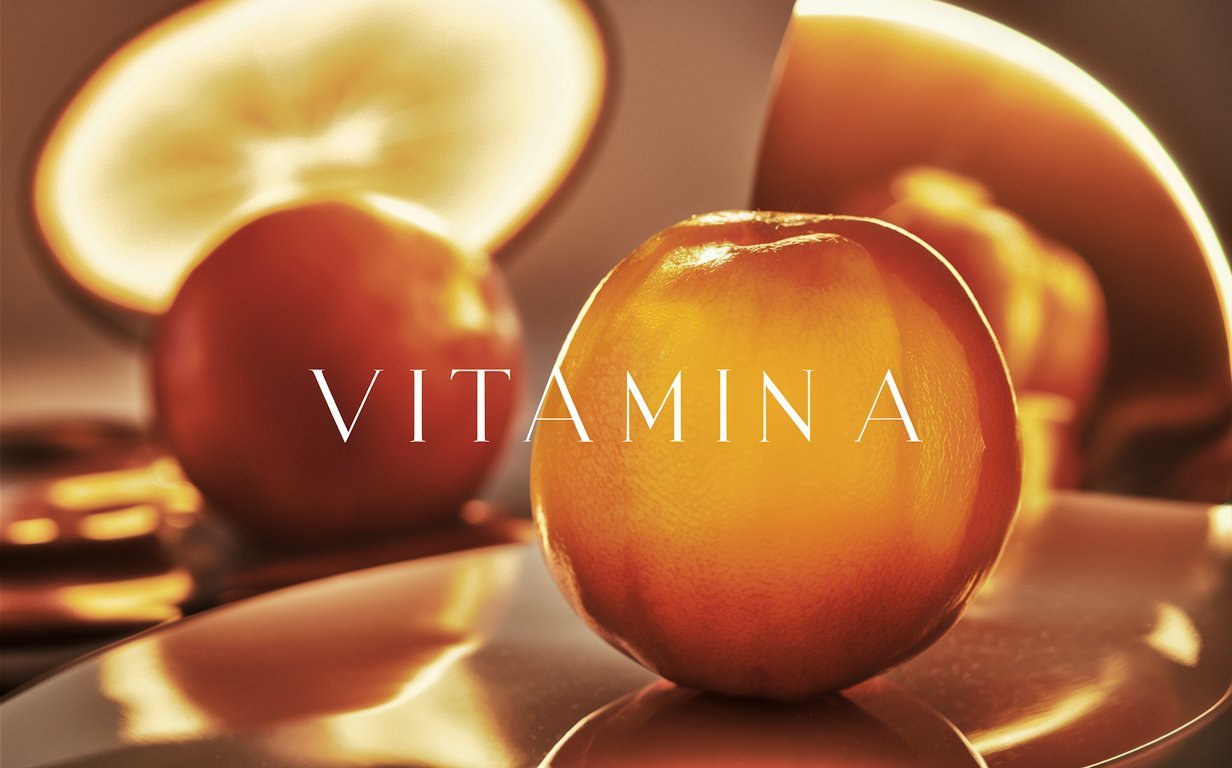Vitamin A is a fat-soluble vitamin that is essential to several bodily physiological functions. The following is a summary of its uses, origins, suggested consumption, and possible health advantages:
Function
Vision
- Vitamin A is necessary to keep your vision clear, especially at night. It is a part of the pigment called rhodopsin, which is located in the retina of the eye and is essential for night vision.
- Adequate vitamin A intake helps prevent conditions like night blindness and may reduce the risk of age-related macular degeneration, a leading cause of vision loss in older adults.

Immunological Support
- Vitamin A aids in the body’s defence against infections and illnesses by supporting the immune system’s regular operation.
- It plays a role in the development and maintenance of mucosal surfaces, such as the respiratory and gastrointestinal tracts, which act as barriers against pathogens.
Skin Health
- It aids in the preservation of healthy mucous membranes and skin, encouraging the healing of wounds and preventing against infections.
- It supports the production of new skin cells and helps regulate sebum production, which can help prevent acne and other skin conditions.

Cell Growth and Differentiation
- Vitamin A is involved in regulating cell growth and differentiation, particularly in tissues like the skin and epithelial linings.
- It plays a role in the development and maintenance of various organs, including the lungs, kidneys, and heart.
Reproductive Health
- Vitamin A is important for reproductive health, including fetal development during pregnancy.
- Adequate vitamin A intake is crucial for normal embryonic development, particularly for the development of the eyes, skeleton, and central nervous system.
Sources
- Preformed Vitamin A (Retinoids): Contains dairy products, fish liver oil, animal products including liver, and egg yolks.
- Provitamin A Carotenoids: Found in orange and yellow fruits and vegetables (carrots, sweet potatoes, pumpkin, mangoes), as well as leafy green vegetables (kale, spinach), as well as plant-based diets.

Recommended Intake
- The recommended dietary allowance (RDA) for vitamin A varies based on age, sex, and life stage. The recommended daily allowance (RDA) for adults is normally between 700 and 900 micrograms of retinol activity equivalents (RAE).
- It’s crucial to remember that taking too much vitamin A from supplements may be hazardous, so it’s best to stick to the suggested dosage limits.
Deficiency Symptoms
- Night blindness – Dry, rough skin – Increased susceptibility to infections, particularly respiratory and gastrointestinal infections – Impaired wound healing – Keratinization of the cornea leading to blindness (in severe cases)
- Eating a balanced diet full of foods high in vitamin A is essential to ensuring an appropriate intake of this vitamin. If needed, supplementation should be done under the guidance of a healthcare professional to avoid toxicity.
Are the vitamin A and retinol the same
Retinol and vitamin A are quite similar, but not exactly the same. One kind of vitamin A, referred to as a retinoid, is retinol. But vitamin A is more than just retinol; it also includes retinal, retinoic acid, and other provitamin A carotenoids.
Retinol is the primary form of vitamin A found in animal products such as liver, fish liver oil, egg yolks, and dairy products. It is considered a preformed vitamin A because it is readily usable by the body without requiring conversion.
On the other hand, plant-based diets including carrots, sweet potatoes, pumpkin, mangoes, and leafy green vegetables include provitamin A carotenoids like beta-carotene, alpha-carotene, and beta-cryptoxanthin. Through a sequence of enzymatic processes, these molecules are transformed by the body into retinol, which serves as a source of vitamin A.
Once ingested by the body, retinol and other forms of vitamin A are vital for many physiological functions, such as immune system performance, skin health, cell proliferation and differentiation, and eyesight.
Retinol is a type of vitamin A, however “vitamin A” includes preformed vitamin A and provitamin A carotenoids.
Will vitamin A help with acne
- Regulation of Sebum Production: Retinoids, derived from vitamin A, help regulate sebum (skin oil) production. When your skin makes too much oil, it can clog your pores and cause acne. Retinoids can help stop acne spots from showing up by controlling the production of sebum.
Promotion of Cell Turnover: Retinoids stimulate the turnover of skin cells by assisting in the discharge of dead skin cells. This helps to prevent the accumulation of dead skin cells inside the pores, lowering the risk of blocked pores and acne outbreaks.
Anti-inflammatory Effects: Retinoids have the ability to decrease inflammation, which may aid in the healing of acne lesions. Retinoids may lessen the redness, swelling, and pain brought on by acne outbreaks by decreasing inflammation.
Treatment of Existing Acne Lesions: Retinoids may aid in the resolution of comedones, which are blocked pores, lessen the size and intensity of papules and pustules, and stop the spread of new acne lesions.
Improvement of Overall Skin Health: By encouraging the formation of collagen, minimizing the appearance of fine lines and wrinkles, and enhancing skin tone and texture, retinoid-derived vitamin A may also aid in the improvement of overall skin health.
It’s important to remember, however, that while vitamin A and retinoids may be useful in treating acne, they can also irritate, dry up, and create skin sensitivity, particularly in the beginning stages of therapy. To reduce discomfort, it’s crucial to utilize retinoid products as prescribed by a healthcare provider and to incorporate them gradually into your skincare regimen.
Retinoids may also cause negative side effects in some people, such redness, peeling, or increased sun sensitivity. It’s imperative that you stop using the product and get further advice from a dermatologist if you have severe or persistent side effects.
Which vitamin a function as a steroid hormone
Retinoids and Vitamin A as Hormone-Like Substances
The following is an introduction to Vitamin A. Fat-soluble vitamin A is vital for several physiological functions, such as immune system performance, cell division, and vision
- Retinoids Formation: Retinoids which comprise compounds like retinol, retinal, and retinoic acid, are derived from vitamin A. These substances are either produced by the body via synthesis or are metabolized from dietary sources of vitamin A.
Nuclear Receptors and Retinoic Acid: Nuclear receptors referred to as retinoic acid receptors (RARs) and retinoid X receptors (RXRs) are liganded by retinoic acid, a byproduct of vitamin A.
Mechanism of Action
- Transcriptional Regulation: Retinoic acid creates a complex with RARs and RXRs that functions as a transcription factor.
Gene Expression: This complex binds to retinoic acid response elements (RAREs) in DNA to control the expression of certain genes.
Cellular Mechanisms: Numerous biological functions, such as cell development, differentiation, apoptosis (cell death), and metabolism, are impacted by the regulated genes.
Similarity to Steroid Hormones
- Nuclear Receptor Interaction: The interaction of retinoic acid with nuclear receptors is similar to how steroid hormones, such as estrogen, testosterone, and cortisol, exert their effects.
- Regulation of Genes: Similar to steroid hormones, retinoic acid affects cellular processes via modifying gene expression in target cells.
Physiological Functions
- Cell Differentiation: Retinoic acid is essential for cell differentiation, especially in tissue regeneration and embryonic development.
- Immune Function: It controls the expression of genes related to the growth, activation, and function of immune cells, hence regulating immunological responses.
- Skin Health: Retinoic acid encourages the turnover of skin cells, which helps to keep skin healthy and ward off conditions like psoriasis and acne.
- vision: Retinoic acid is necessary for the retina’s generation of visual pigments, which supports normal vision, especially in low light.
- To summarize, although vitamin A is not a steroid hormone in and of itself, retinoic acid, a metabolite of vitamin A, functions as a hormone-like substance through its interaction with nuclear receptors and regulation of gene expression. The different bodily functions of retinoids and their medical uses in many areas, such as cancer and skin, are all based on this mode of action.
Clinical application
- Acne Treatment: Topical retinoids are often used to treat acne by lowering sebum production, avoiding pore blockages, and boosting skin cell turnover.
- Dermatological problems: Photoaging, hyperpigmentation, and some forms of skin cancer are among the dermatological problems that can be treated with retinoid therapy.
- Cancer Therapy: The potential use of retinoids in cancer therapy has been studied, with a focus on treating skin malignancies and leukemia.
Side Effects and Precautions
- Dryness and Increased Sensitivity to Sunlight: Topical retinoids may cause dryness, irritation, and increased sensitivity to sunlight.
- Teratogenicity: Systemic retinoid drugs should not be used during pregnancy because they can cause birth problems.
- Monitoring and take: Patients should be kept informed about any side effects and should only take retinoid therapy under the guidance of a medical expert.

To summarize, although vitamin A is not a steroid hormone in and of itself, retinoic acid, a metabolite of vitamin A, functions as a hormone-like substance through its interaction with nuclear receptors and regulation of gene expression. The different bodily functions of retinoids and their medical uses in many areas, such as cancer and skin, are all based on this mode of action.












One Response
The Content is very helpul & informative.